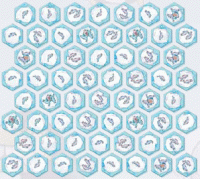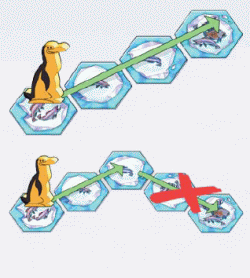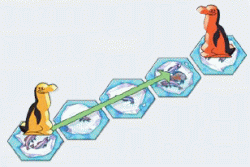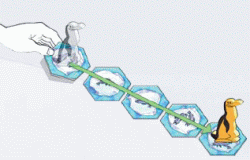[Rule translation by Steve Cox, Nov 2005.]
Introduction
Hungry penguins at the pole hop from ice floe to ice floe in search of fish. They try to block their rivals
and secure the highest yielding fishing grounds for themselves.
At the end, whoever has captured the most fish is the winner of this game to and fro across the floes.
Preparing to play
The 60 ice floes are laid out on the table in a honeycomb pattern, front side up.
The first row should be placed in the middle of the playing area, and should have 8 ice floes. After this, place three rows above (with 7, 8, 7 ice floes) and 4 below (with 7, 8, 7, 8 ice floes).
Altogether there should be 8 rows.
The exact shape of the playing area is not important, but the ice floes with one, two and three fish should be more or less evenly distributed.

Each player gets some penguins in his colour (depending on the number of players):
- With 2 players, 4 penguins each
- With 3 players, 3 penguins each
- With 4 players, 2 penguins each
The youngest player now places one of his penguins on an unoccupied ice floe with one fish. In turn the other players do the same until all of the penguins have been placed on ice floes with one fish.
Playing the game
Once all penguins are on ice floes, the fishing begins!
Packeis am Pol is played in turns. The youngest player begins after which play proceeds clockwise.
A game turn consists of moving one of your own penguins and afterwards removing the ice floe on which the penguin was standing at the beginning of the turn.
A penguin can move as far as he likes over ice floes not occupied by other penguins. The direction of movement is up to him; however he must not change direction during the turn.

A penguin cannot change direction during a game turn!
Ice floes with a penguin (whether your own or belonging to another player) cannot be crossed, and gaps left by the removal of ice floes cannot be jumped over.

The penguin must stop on the ice floe before the other penguin.
At the end of his turn, the player takes the ice floe where his penguin stood at the beginning of his turn, and puts it face up in front of him.

Ice floes that can no longer be reached by any penguin are removed from the game.
Game end
If a player cannot move any of his penguins, he picks up all of his penguins and the ice floes where they stand.
The other players continue playing until they too can no longer move their penguins.
If only one player can move, he carries on by himself as long as possible.
Finally the players count their collected fish. The player with the most fish is the winner. If 2 or more players have accumulated the same number of fish, victory goes to
the one with the most ice floes. If this is also tied, the game ends inconclusively.
The genesis of
PACKEIS AM POL
Alvydas Jakeliunas was born in 1961 in Lithuania, studied physics there and currently works as a
self employed designer. The idea for Packeis am Pol came to him while thinking about artificial intelligence.
Alvydas came across Günter Cornett, owner of Bambus Games, via the internet. The result was Packeis
am Pol, which came out in October 2003 under the name Pingvinas (Lithuanian for penguin) in a limited
edition, that quickly sold out.
Adjustments for the online version: For the ranking table a complete list from winner to loser is needed, including who made the second or third place. As a first criterion the number of fish at the end of game is counted. If there are players with the same number of fish, the number of floes is also considered. If two players are still equal considering both criteria, they are tied/have the same place (the game is a draw in a two-player game or if they are first in a multi-player-game).